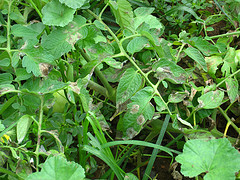
UNIVERSITY PARK – Late blight, the same disease that caused Ireland’s potato famine in the 19th century, was confirmed in three Pennsylvania counties last week.
Potatoes and tomatoes in commercial production fields in Blair, Franklin and Mifflin counties have been hit, according to Beth Gugino, assistant professor of plant pathology in Penn State’s College of Agricultural Sciences. She added that while late blight has been found only in commercial fields so far, home gardeners should be vigilant for symptoms in their plants as well.
Late blight affects potatoes and tomatoes, and its symptoms appear similar for both crops. Growers should watch for a pale green or water-soaked spot that becomes brown. Also, the underside of the leaf will have fuzzy growth and appear whitish grey, and the stems can have long, chocolate-brown lesions.
Recent weather conditions have been favorable for late blight, Gugino explained. The pathogen prefers cool, wet conditions and thrives in temperatures between 65 and 70 F with high relative humidity.
“Warm weather hopefully will slow it down,” she said. “It won’t kill it, but the disease won’t really progress when it gets warm and dry.”
To prevent late blight, growers can apply protectant fungicides, and some copper-based products can be used in organic operations. However, Gugino said that if severe late blight symptoms are present in a garden or commercial crop, affected plants should be destroyed so they are no longer a source of the pathogen. Fungicides that are more specific for late blight also should be used.
She noted that late blight is difficult to manage and emphasized that communication is key in minimizing late blight outbreaks.
“If people suspect they are seeing late blight, it’s really important they communicate that to the appropriate people,” Gugino said. She suggested that suspected late blight can be reported to the nearest Penn State Extension office, to the Penn State Plant Disease Clinic or to her atbkgugino@psu.edu.
“If they don’t report it, this disease will not only affect their crop, it potentially will affect other people’s gardens and commercial crops.” She pointed out that late blight outbreaks in 2009 resulted in considerable losses for both home gardeners and commercial growers across the Northeast.
Gugino said that researchers are interested in obtaining samples of plants that are affected so that they can better understand and manage the disease.
Growers can find more information and pictures of late blight here. The Commercial Vegetable Production Recommendations Guide also provides information on fungicides that are registered for managing late blight. The website http://usablight.org provides information such as locations of reported outbreaks and strategies for managing late blight.


